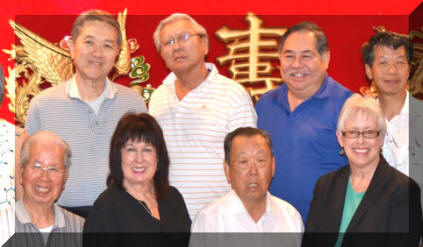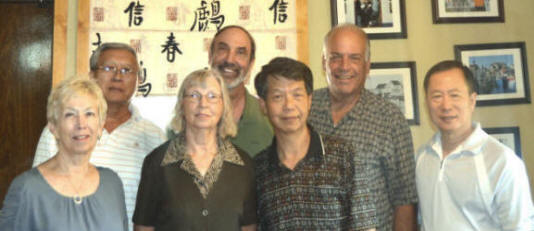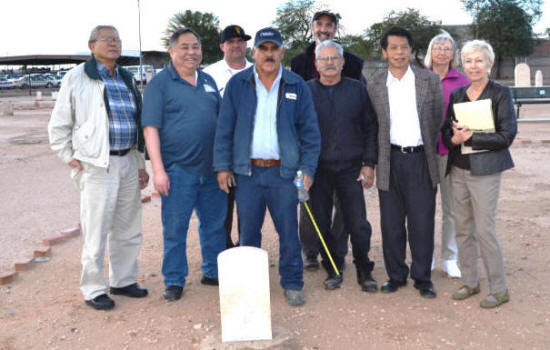| |
《鳳凰城華人先民紀念墓碑 》奠基安放
这里埋葬着一批最早来亞利桑那州的華人,这里有亞省華人遺留下來最早的墓碑和中國文字。 这墓地上的《鳳凰城華人先民紀念墓碑 》即将奠基安放。
鳳凰城的《先民和軍人紀念墓園》(Pioneer & Military Memorial Park),是一個早期的有著歷史意義的墳場,墓地中有不少著名人物,內中保存著許多重要的信息。在這11英畝的墓地上,有3700墓葬,約600墓碑,墓園分7個區,而早期華人的墓地,也在窮人墓區之中。從1886年到1914年,有50位有中國血統的華人和後代被埋葬在華人墓地,其中部分的遺骸已被他們的親人起出運回中國,很少人知道這些墓葬者的資料,因為他們一般都不會出現在報紙上,除了查明個別家庭的資料外,有些只有姓名,沒有他們後人的消息。
1993年,ASU大學研究人類學者K.
J. Schroeder和考古小組在墓園里進行發掘,出土了一些中國錢幣、骨器、玉器和小菩薩像等物件,考古學者主編了一本書籍:"Pioneer
& Military Memorial Park Archaeological Project in Phoenix
Arizona 1990-1992"。
墓地中有惟一的一塊中文墓碑,墓碑矮小單薄, 碑文只有:"開平大樓村人鄧湘遠墳墓",沒更多的線索。學者請當年Tempe首届中文校長唐孝先先生,在華人報刊上刊登消息,試圖找尋墓葬者的後代,以期研究其生平、思想、家族等,藉此宏揚華人開拓亞省的光榮歷史。但20年過去了,郤一直未能解開這個"墓碑之謎"。
現任華人福利會會長張肇鴻,多年來搜集相關資料,希望能解開這個墓碑謎團。在尋覓過程中,從查詢姓名到翻閱族譜,從跟進歷史到拜訪前僑,從美國墓園查詢到中國僑鄉。張肇鴻在華文報刊和網站先後發表了10篇文章,引起僑界泛反響,有不少老僑提供线索,並得到墓園方面的協助,经过多年的努力,終於讓謎團有了答案。资料显示:鄧湘遠是相当早来到亞利桑那州的華人,他的墓碑是亞省華人遺留下來的最早的墓碑,碑文是亞省最早的中國文字。墓碑對今後研究亞省華人的歷史文化有很大的參考價值。而在鄧湘遠後代的族譜中,有一位是美國第9巡迴法院大法官鄧心平(1922年—1995年),鄧心平名字的出現,讓墓碑謎團到最後帶出了一個光環。
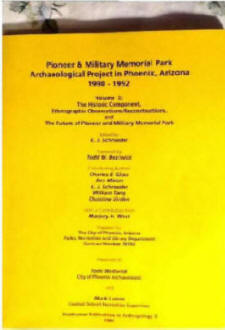 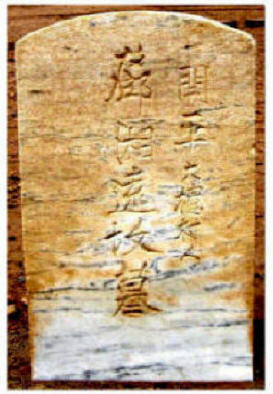
2014年5月26日,鳳凰城僑界到《先民和軍人紀念墓園》展開對華僑先民的追悼和拜祭活動。包括資深僑領余文勁、鳳凰城僑聯總會、斐匿華人福利會、鄧高密公所、余風采堂、開平同鄉會、中國餐館協會、榮光會、台聯會、龍岡公所、學術界、亞省太陽鳥華人網等團體的成員,向華人墓地獻上花圈花藍,鞠躬致敬,在慎終追遠中,寄托對華人先輩的悼念。
有一個很深的感触,在早期華人墓地里埋葬有五十華人,當年無論生前死後都是地位低微,是受岐視的一族,在那個排華時代,他們有著許多心酸的故事。百年前鄧湘遠先輩的墓碑矮小單薄,有如是那個時代華人的歷史地位低微的寫照。由於年代久遠,鄧湘遠連魂歸故里、尋覓至親之路也困難重重。他的墓碑在曠野荒塚中自憐,在歷史寂寥歲月中等待......。今天,這一頁終於翻過。墓碑為亞省華人留下了一份珍貴的歷史文化遺產。今後,"華人墓園第一碑"和鄧湘遠名字將不會再被人們遺忘。張肇鴻專門去和鄧湘遠的墓碑照了張相,也去了另一個"綠木墓園"的"華人紀念墓園"碑照了一張相,以此用作對照。
鳳凰城"綠木墓園"(Greenwood/Memory Lawn Mortuary & Cemetery)創建於1906年,是亞利桑那州最大的墓園 。
一九九二年,亞省的著名僑領余文勁先生,有感於華人墓地不集中,聯同華人福利會和綠木墓園管理層商議,新開辟出亞省首個"華人墓地公園"(Chinese
memorial garden),不但樹立有紀念墓園石碑,還專門內建尊貴地位的"王室墓地",充分反應出綠木墓園高層對華人地位的尊重。這是在一百多年前,華人做夢都想不到的變化。由於墓園為華人著想,尊重華人的文化風俗,目前已有大批華人置地安葬。
今天,華人的地位有了顯著的提升,從篳路藍縷到大路開闊,從受其岐視到受其尊重。在不斷地溶入主流社會中,觀念和胸懷也在不斷擴充,華人不再沈鬱在過去的歷史和社會所給予的不公,而是更積極去面對,為日臻完善制度作出貢獻,並勇於參與未來的開拓和創新。
華人墓地仍埋葬著廿余位華人先民,斐匿華人福利會决定为他们立一個紀念墓碑,讓這些在最早期開拓亞利桑那州華人的先民們,也能得到應有的地位和尊重。这个决定得到了鳳凰城市政府
、墓園决策高层、資深僑領余文勁和鳳凰城僑聯總會的高度重视和大力支持。目前,
紀念墓碑已建造好。12月21日,市政府施工部门的Dustin
Marut,
綠木公墓的總經理戴維·沃克David Walker,先民紀念墓園主管馬克·拉姆Mark
Lamm,鳳凰城僑聯總會主席 David
Yee,
福利會會長Homer
Zhang等到实地考察墓碑安放地点。奠基近日进行,鳳凰城僑界将擇日举行隆重纪念儀式。
The Foundation
Ceremony for the Monument to the Phoenix Chinese Ancestors
Phoenix's Pioneer & Military Memorial Park is one of the earliest
cemeteries in Phoenix with significant historic values. The
cemetery is the burial ground for many famous people and preserves
much important information about the early settlers of Arizona. On
the 11-acre cemetery divided into seven zones, there are 3,700 tombs
and about 600 tombstones. The early Chinese settlers were buried
among the poor in the cemetery. From 1886 to 1914, there were 50
Chinese and Chinese descendants buried in the cemetery and many of
these Chinese’ remains were later transferred back to China by their
loved ones. Since these Chinese did not appear on the obituary
sections of the local newspapers, there is very limited information
in identifying these Chinese nor their families and descendants.
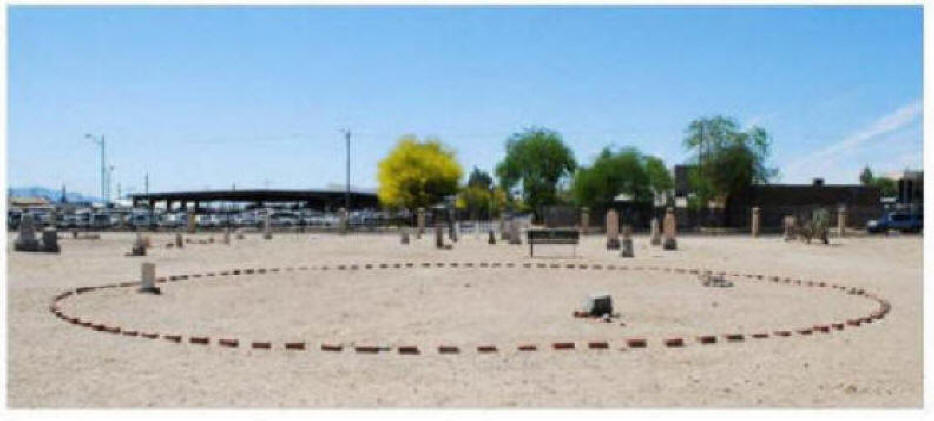
In 1993, ASU anthropologists K.J Schroeder and his archaeological
excavation team excavated the cemetery and unearthed some Chinese
coins, bone made tools, jade, small Bodhisattvas and other objects.
The archaeologist published the book, "Pioneer & Military Memorial
Park Archaeological Project in Phoenix Arizona 1990-1992." Among the
early tombstones in the cemetery, there is only one with Chinese
inscription - "Grave of Xiang Yuan Tang, Kaiping Dai Lou Village.”
With little clues about this tomb, the archaeologist reached out to
the Tempe Chinese school principal, William Tang. Mr. Tang
published a message in the local Chinese newspaper, hoping to find
the descendants of the tomb in order to study the life, thoughts and
family of the tomb owner and to promulgate the glorious history of
the Chinese pioneers. But 20 years passed by, the tombstone mystery
had remained unsolved.
 
Homer Zhang, President of Phoenix Chinese Welfare Council, has spent
years in collecting relevant information in hopes to unravel the
mystery tombstone, through querying Chinese family names,
researching genealogy records, visiting former overseas Chinese, and
inquiring cemeteries in U.S. and China. Mr. Zhang published over 10
articles online and through local Chinese newspapers on the mystery
tombstone. Mr. Zhang’s articles received vast feedbacks from the
Chinese communities -- many senior overseas Chinese provided clues
and the cemetery offered help. After years of effort, the mystery
had finally been solved. According to Mr. Zhang’s research, Xiang
Yuan Tang is found in the genealogy records of the family of Thomas
Tang (1922-1995), Justice of the U.S. Ninth Circuit Court. Xiang
Yuan Tang is one of earliest Chinese settler in Arizona and his
tombstone is the earliest tombstone inscribed with Chinese
characters. His tombstone provides great reference value for the
future research of Chinese history in Arizona.
May 26, 2014, Chinese community leaders and members of the Chinese
community organizations visited the Chinese cemetery of the Pioneer
& Military Memorial Park in commemorating the Chinese ancestors and
pioneers with wreath flowers. They were senior Chinese community
leader John M. Yee, and representatives from Chinese United
Association of Greater Phoenix, Phoenix Chinese Welfare Council, Ong
Ko Met Family Association, Yee
Fung Toy Family Association, Kaiping Benevolent
Association of Phoenix, Chinese
Restaurant Association of Arizona, Ying
On Merchants & Benevolent Association, Taiwan
Benevolent Association of Phoenix, Lung
Kong Family Association of Phoenix Arizona, Phoenix academia,
Arizona Sunbird News.
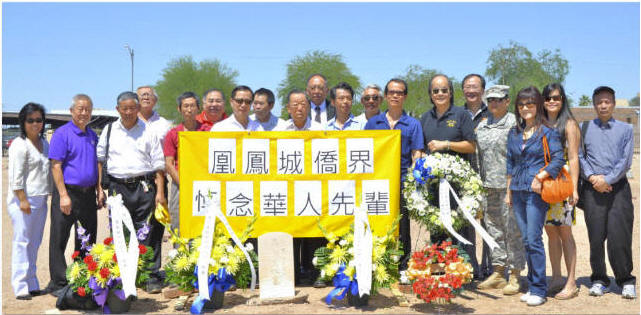
There is a deep feeling about the fifty Chinese pioneers who buried
in the early Chinese cemetery. Either in life or after death, these
Chinese are classified with low status, subjected to discrimination
in the era of anti-Chinese. Their lives were filled with a lot of
sad stories. Xiang Yuan Tang’s thin little tombstone is a humble
portrayal of the Chinese status during the era. As Tang was buried
ages ago, it seems it is so difficult for his soul to return to
hometown and join his loved ones. His tombstone stands in the
neglected cemetery in self-pity, as if it is waiting ... in solitude
years. Today, the page of Chinese pioneers is finally turned.
Chinese tombstones provide us with precious historical and cultural
heritage values. From now on, "the First Chinese Cemetery Monument"
and the name of Xiang Yuan Tang will no longer be forgotten.
Followings are two pictures Homer Zhang took in contrast: one by the
Xiang Yuan Tan’s tombstone at the old cemetery, and the other by the
Chinese Cemetery Memorial monument at the Greenwood Memory Lawn
Mortuary & Cemetery.

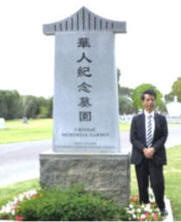
The current Chinese cemetery is located at Greenwood Memory Lawn
Mortuary & Cemetery. Greenwood Memory Lawn Mortuary & Cemetery is
founded in 1906 and it is the largest cemetery in Arizona. In 1992,
Chinese community leader, John M. Yee, realized the Chinese
cemeteries were not centralized in term of location. Therefore, he
worked with Phoenix Chinese Welfare Council and the Greenwood
Cemetery management to negotiate the opening up of the Phoenix’s
first "Chinese Cemetery Park" (Chinese Memorial Garden). The
Greenwood Cemetery management not only established a monument to
commemorate the Chinese cemetery, but also developed a sector as
"royal cemetery," namely luxury grave sites, reflecting the
management’s high level of respect for the Chinese. This level of
respect would never occur in the past. As result of the high
respect in the Chinese culture and customs, there is a great demand
for the Chinese to choose the Greenwood Cemetery as their burial
site. Today as the Chinese social status has been significantly
improved and have integrated with the mainstream, they are no longer
depressed with injustice of the past, but more actively to face it
and involved to improve the system. They also take the courage to
participate in the future development and innovation.
Currently,
the old Chinese cemetery still has about twenty Chinese ancestors
buried there. The Phoenix Chinese Welfare Council decided to
establish a monument in memory of these Chinese pioneers in Arizona
for their great contribution to the Chinese community. This decision
has been strongly supported by the Phoenix city government,
executives of the cemetery and Chinese United Association of Greater
Phoenix. The monument has now been built and a date for installation
and commemoration ceremony is yet to be decided by general manager
of the Greenwood Cemetery, David Walker, and Phoenix Parks &
Recreation manager, Mark Lam, Phoenix
Depatmemt Park Foreman Dustin Marut, Chinese
United Association of Greater Phoenix President David Yee, Homer
Zhang, Cheak Yee, Jim Tang and
Jim Ong.
Photo/article
by homer zhang
|
|








